
Click to enlarge. A huge flower of the rare and mysterious Dracula terborchii, first discovered in an orchid collection in Europe. Recently its home was discovered by Ecuadorian orchid scientists. Dracula terborchii is one reason we chose this area to protect. Photo: Lou Jost/EcoMinga.
In January orchid enthusiasts Peter Tobias, Kathi McCord, Steve Beckendorf, Mary Gerritsen, and Spiro Kasomenakis came to visit our Dracula Reserve in northwest Ecuador, near the town of Chical on the Colombian border. Peter, Steve, and Mary are founders and board members of the Orchid Conservation Alliance, which has been raising money for EcoMinga’s conservation work since its inception in 2006. Lately they have been major supporters of our Dracula Reserve, and they were eager to see it for themselves. They were especially interested in the orchid tribe that make up the bulk of the orchid diversity here, Pleurothallidinae, a group of mostly-miniature orchids that includes genera like Masdevallia (Mary had even written a book about that genus with Ron Parsons, and another book about miniature orchids in general), Lepanthes, Stelis, Pleurothallis, and of course Dracula. Perfect guests for a reserve established specifically to conserve those orchids!
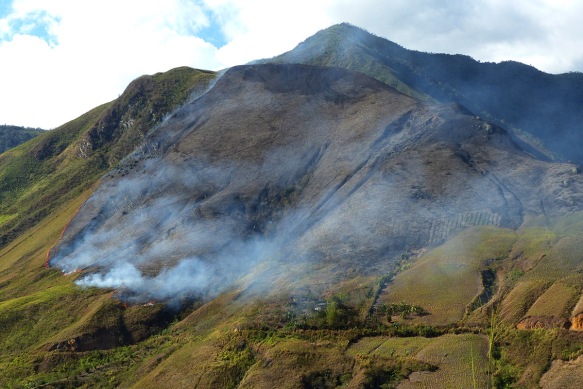
Click to enlarge. A line of fire destroys a mountain in the Mira valley. Note the flames on the left edge of the burned area. The Dracula Reserve is in the mountains above this. This was taken on a previous trip to the reserve. On this trip we only saw the effects of these fires. Photo: Lou Jost/EcoMinga.
The long drive from Quito to the reserve is depressing. On the central inter-Andean plateau we pass through a barren, eroded landscape almost entirely lacking in large trees. Then we turn west to descend the Mira valley, which once had tall dry forest near the river and cloud forest on the upper slopes. Now there are only large expanses of treeless slopes swept repeatedly by deliberately-set fires. But by mid-afternoon we begin our climb on side roads into the high mountains. In the transition zone between destruction and paradise we reach the beautiful hacienda La Primavera where we will stay. We have three days to explore our four reserve units, the nearest about a half-hour’s drive from the hacienda.

Our hotel, Hacienda Primavera (www.haciendaprimavera.com). Highly recommended!! Photo: Lou Jost/EcoMinga.
The rain falls constantly, since the morning of the first day. The cool temperatures and 100% humidity are deadly for electronics and optics, and nearly everyone’s cameras (some of them professional quality Nikons and Canons) begin to fail electronically, while even the ones that don’t fail have fogged lenses. Nevertheless everyone is in good spirits because this is exactly the right climate for the miniature orchids we seek.

Lepanthes generi, a recenly-described species from this area. Photo: Lou Jost/EcoMinga.
The most diverse genus is Lepanthes. I’ve posted about Lepanthes from this area before; they have tiny but intricate flowers that attract male fungus gnats which mate with the flower, thinking it is a female fly. The flower makes female fly pheromones to lure the males in. There are over 300 species of Lepanthes in Ecuador, and our Dracula Reserve parcels seem to have an endless variety of them. Many are recently discovered species, apparently found only here in the vicinity of our reserve, though some of these surely reach into nearby Colombia. We try to photograph as many as we can, but the rain makes this an exercise in frustration. Try balancing an umbrella on your shoulder while steadying a tiny flower with one hand and a heavy camera in the other, to take a nearly-microscopic photo whose depth of field at these magnifications can be as little as a couple of millimeters. If we are able to see the flower through our wet glasses and fogging lenses, we watch it go in and out of focus uncontrollably as we try to hold still, and if the flower is in focus at the moment we press the shutter, it’s pure luck.
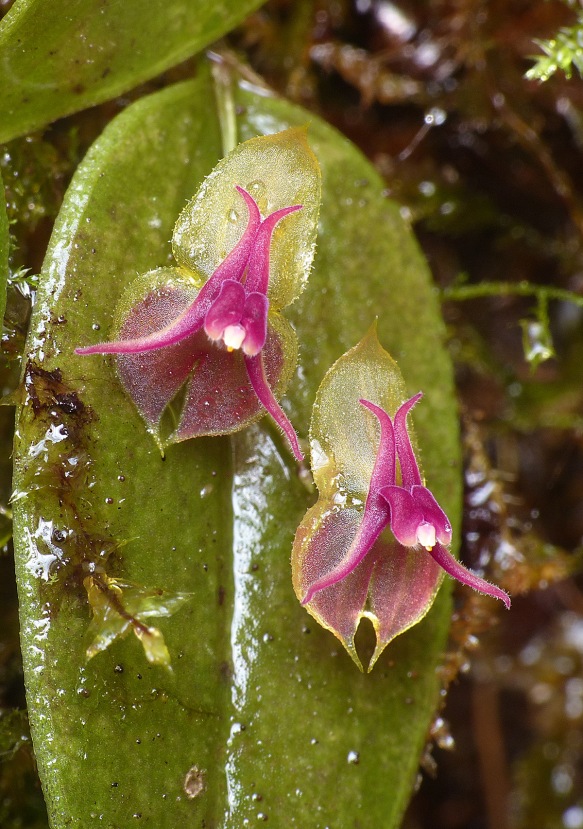
Lepanthes meniscophora in the reserve. Click to enlarge. Photo: Lou Jost/EcoMinga.

Click to enlarge. Dracula andreettae in our reserve. Photo: Lou Jost/EcoMinga.
Already from the first moment we find our focal genus, Dracula. The sinister convoluted Dracula andreettae is the most spectacular thing we find the first day. Dracula gigas in the same area is also stunning. Dracula plants without flowers are more common than those with them; ironically, our local reserve caretaker Hector Yela explains that this is because there was a weeks-long unseasonably dry spell just preceding our soggy visit.
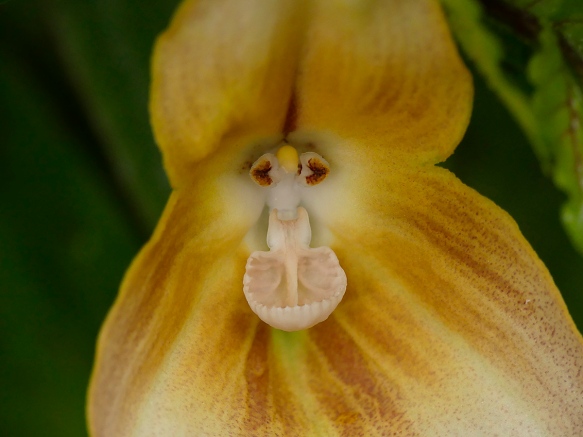
Dracula gigas. Photo: Lou Jost/EcoMinga.

Steve Beckendorf photographs Dracula gigas in our Dracula Reserve. Photo: Lou Jost/EcoMinga.
Dracula and most other orchids here are epiphytes, growing in the trees. But many of the most interesting and overlooked orchids are terrestrial species related to temperate-zone North American orchids. I pay special attention to these, and our guest Spiro also has an exceptionally good eye for them. On this trip we find two apparently-different species of the terrestrial orchid Psilochilus, a genus related to the elusive Triphora trianthophora of North America. Triphora is partly saprophytic, a vulture-like plant living on decaying material (in symbiosis with fungi) rather than making its own food with its leaves. Psilochilus has more nearly normal leaves and probably does not need decaying material. But like Triphora, Psilochilus has flowers that only last a day or two, so it takes good timing to find one in flower. Most orchid scientists never notice them. My fieldwork has shown that there are far more species of Psilochilus in Ecuador than the very few officially-described species. Maybe one or both of these forms are new, or at least new for Ecuador. Several new species were recently described from nearby Colombia.

A beautiful Psilochilus species in the Dracula Reserve. Photo: Lou Jost/EcoMinga.
Another terrestrial, a species of Cleistes, catches our attention each day as we pass the clearing where it grows. On the first day the buds looked ready to pop open, so each time we pass, we eagerly get out of our vehicle and check them. Day after day they just sit there, the petals and sepals slightly ajar like the flowers are about to unfold, but they never do. At first I thought it might be self-pollinating, and the plants had many seed capsules, which is often a sign of self-pollination.But when I dissected one, I found it had functional nectar glands at the base of its lip (a modified petal). I tasted it to be sure. Very sweet!

An odd Cleistes species (Orchidaceae) which never opens more than this. Photo: Lou Jost/EcoMinga.

Side view of an odd Cleistes species which never opens more than this. Photo: Lou Jost/EcoMinga.
On the last full day, the rain is worse than usual. We visit a site we would like to purchase, home of some of the rarest Dracula species. But when we arrive we find some of the forest has been cut down. The fallen trees show us the otherwise-hidden diversity of the canopy orchids in this forest.
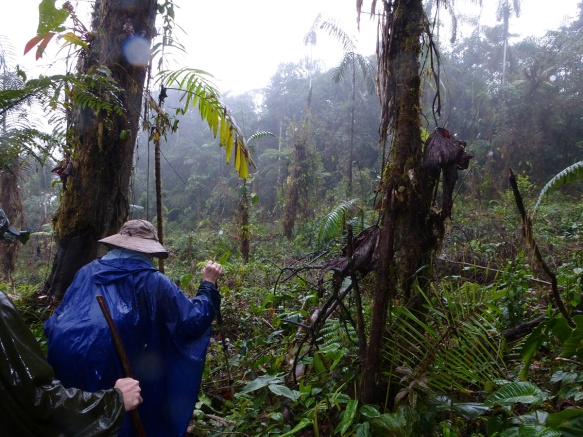
A new clearing surprised us as we went to look for the rare Dracula trigonopetala. This was forest last time I was here, and we wanted to try to buy it. Luckily most of the forest is still intact and full of rare orchids. This will be a high priority to buy as fast as possible. Photo: Spiro Kasomenakis.

Cyrtochilum geniculatum in the fallen crown of a cut-down tree in a property we hope to purchase soon. Photo: Lou Jost/EcoMinga.
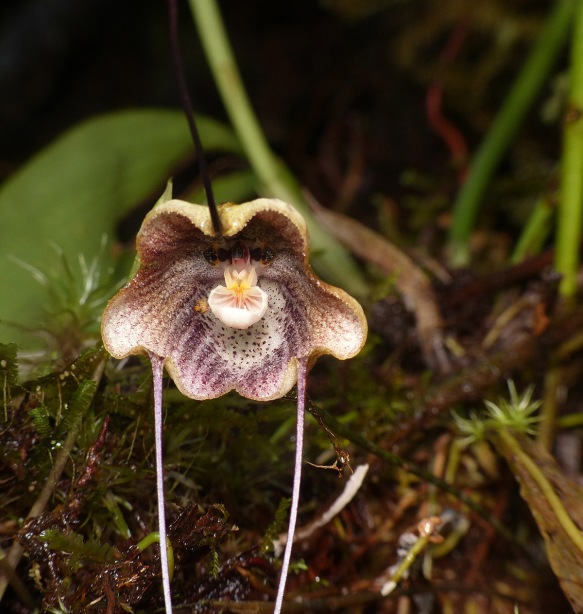
Click to enlarge. The recently-described Dracula trigonopetala, one of the rarest Dracula species of the area. Photo: Lou Jost/EcoMinga.
Luckily the rare Dracula we had come to see, the recently-described Dracula trigonopetala, was a few dozen meters from the clearing, still in good shape. Now some especially waterlogged participants turn back towards the road, but a few of us continue on. After a long cold wet hike, we reach an area with Lepanthes everywhere, of many different species.

Lepanthes nautica?, one of the recently-described Lepanthes species from this area. Photo: Lou Jost/EcoMinga.

Click to enlarge. Lepanthes nautica, side view. The white organ hanging under the column is the “appendix”, which imitates the genitalia of a female fungus gnat. Male gnats mate with the flower, effecting pollination. Photo: Lou Jost/EcoMinga.
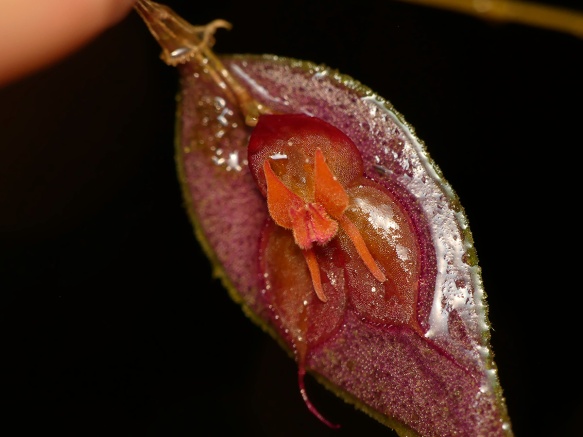
A rain-soaked Lepanthes lycocephala in the Dracula Reserve. Photo: Lou Jost/EcoMinga.

Porroglossum eduardii, a rare species whose lip (with black base in the photo) flips up when an insect lands on it. The trapped insect must crawl out between the lip and the female and male parts of the column, in that order, pollinating the flower. This photo was taken on a previous trip; we only saw none-flowering plants of this species on this trip. Photo: Lou Jost/EcoMinga.
Those of us whose cameras are still semi-functional manage a few shots in the rain, and then we turn back. But as we head back, thinking of warm food and dry clothes, our caretaker Hector looks back towards us and spots an enormous Dracula above our heads. It’s a magnificent Dracula terborchii, a species that was discovered in captivity in Europe, exported from somewhere in Ecuador, mislabelled as a different species of Dracula. For a long time no one knew where in Ecuador it actually lives, but recently Ecuadorian orchid specialists like Alex Hirtz, Luis Baquero (who also co-described D. trigonopetala, along with Gary Meyer) and Francisco Tobar had begun to find a few plants of it in this region. I’d never seen it before in the wild. Its sepals were patterned like a Persian carpet, and against the dark forest it glowed in spite of the gloom. This was the most magnificent find of the trip. We vow to try to purchase this property as soon as possible to keep it from being cleared further. This will not be easy–we’d tried buying it before, but there were conflicting land titles that complicated things. Still, we’ve resolved worse problems. We all agreed this is clearly worth protecting.

The mushroom-like lip of Dracula terborchii attracts fungus gnats which pollinate the flower. Photo: Lou Jost/EcoMinga.
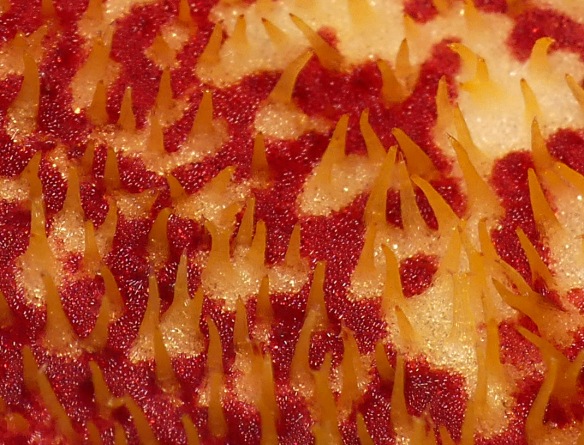
The sepals of Dracula terborchii are covered with thick rigid spikes.

Backlit Dracula terborchii. Click to enlarge. Photo: Lou Jost/EcoMinga.
As the rains defeat the last of the cameras, we head for home. Mudslides begin to fall into the mountain road, but we get through them. Hot showers and good food and company await us in the hacienda, a nice end to a beautiful trip.

On our way back to Quito, finally with sunny weather! From left to right: Spiro Kasomenakis, Kathi McCord, Mary Gerritsen, me, reserve guard Hector Yela, and Steve Beckendorf.
Many thanks to the Orchid Conservation Alliance, whose donations to the Dracula Reserve were matched by the Rainforest Trust, a key partner in this initiative. Thanks also to Vera Lee Rao, Steven K. Beckendorf and Cynthia L. Hill, and Mark Wilson for their major donations to this project. Heinz Schneider and the University of Basel Botanical Garden, which was the initial sponsor of the Dracula Reserve and is still our energetic partner in the project, also deserves special thanks, along with Susann Zeigler and Max Annen, Beat and Urs Fischer and the many other donors named in the U. of Basel Botanical Garden web page.
A special thanks to the Asociacion de Orquideologia de Quito, Ecuador, who raised money for conservation in Ecuador over several years and donated it all to us for this project.
Lou Jost
EcoMinga Foundation

The lip and column (an organ that combines anthers and pistil, characteristic of orchids) of the never-opening Cleistes. The original photo is a 100 Mb “stack-and-stitch” photo composite made from about 30 pictures, to increase resolution and depth of field. Photos: Lou Jost/EcoMinga.
Orchid Conservation Alliance site visit to our Dracula Reserve
—-
La Alianza para la conservación de orquídeas visita nuestra Reserva Drácula
IMG 01- Click para agrandar. Una gran flor del raro y misterioso Dracula terbochii, descubierta por primera vez en una colección de orquídeas en Europa. Recientemente, su hogar fue descubierto por científicos de orquídeas ecuatorianos. Dracula terbochii es una de las razones por las que elegimos esta área para protegerla. Fotografía: Lou Jost/EcoMinga
En enero los entusiastas de orquídeas Peter Tobias, Kathi McCord, Steve Beckendorf, Mary Gerristen, y Spiro Kasomenakis, vienen a visitar nuestra Reserva Drácula en el nororiente del Ecuador, cerca del pueblo de Chical en los bordes colombianos. Peter, Steve y Mary son fundadores y miembros de tablero de la
Alianza para la Conservación de Orquídeas, la cual ha estado recaudando dinero para el trabajo de conservación de EcoMinga desde sus inicios en 2006. Últimamente han sido importantes partidarios de nuestra Reserva Drácula, y estaban ansiosos por verlo por sí mismos. Ellos estaban especialmente interesadas en la tribu de orquídeas que constituye la mayor parte de la diversidad de orquídeas en su mayoría en miniatura que incluye géneros como Masdevallia (Mary incluso había escrito
un libro sobre ese género con Ron Parsons, y otro libro sobre
las orquídeas en miniatura en general), Lepanthes, Stelis, Pleurothallis, y por supuesto, Drácula. ¡Invitados perfectos para una reserva establecida específicamente para conservar esas orquídeas!
IMG – Click para agrandar. Una línea de incendio destruye una montaña en el valle Mira. Observe las flamas al lado izquierdo del área quemada. La Reserva Drácula está en las montañas sobre esto. Esta fue tomada en un viaje previo a la reserva. En este viaje solo vimos los efectos de estos incendios. Fotografía: Lou Jost / EcoMinga
El largo viaje desde quito a la reserva es deprimente. En la meseta interandina central pasamos por un paisaje árido y erosionado que carece casi por completo de grandes árboles. Luego giramos hacia el oeste para descender el valle de Mira, que una vez tuvo bosque seco alto cerca del río y bosque nuboso en las laderas superiores. Ahora solo hay grandes extensiones de laderas sin árboles barridas repetidamente por incendios provocados deliberadamente. Pero a media tarde comenzamos nuestro ascenso por caminos secundarios hacia las altas montañas. En la zona de transición entre la destrucción y el paraíso, alcanzamos la hermosa hacienda
La Primavera donde nos quedaremos. Tenemos tres días para explorar nuestras cuatro unidades de reserva, la más cercana a una media hora en auto de la hacienda.
La lluvia cae constantemente, desde la mañana del primer día. La temperatura fría y la humedad al 100% son mortales para la electrónica y la óptica, y casi todas las cámaras (algunas de ellas Nikon y Canon de calidad profesional) empiezan a fallar electrónicamente, mientras que incluso las que no fallan tienen lentes empañadas. Sin embargo, todo el mundo está de buen humor porque este es exactamente el clima adecuado para las orquídeas en miniatura que buscamos.
IMG – Lepanthes generi, una especie recientemente descrita para esta área. Fotografía: Lou Jost / EcoMinga.
El género más diverso es Lepanthes. He publicado acerca de
Lepanthes para esta área antes; tiene flores pequeñas pero intrincadas que atraen a los mosquitos del hongo macho que se aparean con la flor, pensando que es una mosca hembra. La flor produce feromonas de mosca hembra para atraer a los machos. Hay más de 300 especies de Lepanthes en Ecuador, y nuestras parcelas de Reserva Drácula parecen tener una amplia variedad de ellas. Muchas son especies recientemente descubiertas, aparentemente encontradas solo aquí en la vecindad de nuestra reserva, aunque algunas de estas seguramente llegan hasta la cercana Colombia. Nosotros tratamos de fotografiar tantas como podemos, pero la lluvia hace que este sea un ejercicio de frustración. Intentar balancear un paraguas en tu hombro mientras estabilizas una pequeña flor con una mano y una cámara pesada con la otra, para tomar una fotografía casi microscópica cuya profundidad de campo con estos aumentos puede ser tan pequeña como un par de milímetros. Si somos capaces de ver la flor a través de nuestras gafas mojadas y lentes empañadas, la vemos entrar y desenfocarse incontrolablemente mientras tratamos de quedarnos quietos, y si la flor está enfocada en el momento en que presionamos el obturador, es pura suerte.
IMG –
Lepanthes meniscophora en la reserva. Click para agrandar. Fotografía: Lou Jost / EcoMinga
IMG – Click para agrandar.
Dracula andreettae en nuestra reserva. Fotografía: Lou Jost / EcoMinga
Ya desde el primer momento, nos encontramos con nuestro género focal, Drácula. El siniestro y enrevesado Dracula andreettae es la cosa más espectacular que encontramos el primer día. Dracula gigas, en la misma zona, también es impresionante. Las plantas de Dracula sin flores son más comunes que las que las tienen; irónicamente, nuestro cuidador de reserva Hector Yela, explica que esto es se debe a que hubo una racha de sequía inusualmente larga de una semana justo antes de nuestra empapada visita.
IMG –
Dracula gigas. Fotografía: Lou Jost / EcoMinga
IMG – Steve Beckendorf fotografía Dracula gigas en nuestra Reserva Drácula. Fotografía: Lou Jost/EcoMinga
Drácula y la mayoría de otras orquídeas aquí son epífitas, creciendo en los árboles. Pero muchas de las orquídeas más interesantes y pasadas por alto son especies terrestres relacionadas a las orquídeas Norteamericanas de zonas temperadas. Pongo especial atención a estas, y nuestro invitado Spiro también tiene un ojo excepcionalmente bueno para ellas. En este viaje encontramos dos especies aparentemente diferentes de las orquídeas terrestres Psilochilus, un género relacionado al elusivo Triphora trianthophora de Norteamérica. Triphora es parcialmente saprofítico, una planta parecida a un buitre que vive de material en descomposición (en simbiosis con hongos) en lugar de producir su propia comida con sus hojas. Psilochilus tiene hojas más cercanas a lo normal y probablemente no necesita material en descomposición. Pero como Triphora, Psilochilus tiene flores que solo duran uno o dos días, por lo que se necesita un buen momento para encontrar una en flor. La mayoría de los científicos de orquídeas nunca las notan. Mi trabajo de campo también ha mostrado que hay muchas más especies de Psilochilus en Ecuador que las muy pocas especies descritas oficialmente. Quizás una o ambas de estas formas sean nuevas, o al menos nuevas para Ecuador. Muchas especies nuevas han sido recientemente descritas de la vecina Colombia.
IMG – Una nueva especie de Psilochilus hermosa en la Reserva Dracula. Fotografía: Lou Jost / EcoMinga
Otra especie terrestre, una especie de Cleistes, capta nuestra atención cada día a medida que pasamos el claro donde crece. En el primer día, los brotes parecían listos para abrirse, así que cada vez que pasamos, salimos ansiosos de nuestro vehículo y los revisamos. Día tras día simplemente se sientan allí, los pétalos y sépalos ligeramente entre abiertos como las flores están a punto de desplegarse, pero nunca lo hacen. Al principio pensé que podría ser autopolinizada, y las plantas tenían muchas cápsulas de semillas, lo que a menudo es un signo de autopolinización. Pero cuando diseccioné una, descubrí que tenía glándulas de néctar en la base de su labio (una pétalo modificado). Lo probé para estar seguro. ¡Muy dulce!
IMG – Una extraña especie de Cleistes (Orchidaceae) que nunca se abre más que esto. Fotografía: Lou Jost / EcoMinga
IMG – Vista lateral de una extraña especie de Cleistes, la cual nunca se abre más que esto. Fotografía: Lou Jost / EcoMinga
En el último día completo, la lluvia esta peor de lo usual. Visitamos un sitio donde nos gustaría comprar, hogar de algunas de las especies de Dracula más raras. Pero cuando llegamos encontramos algunos de los bosques que han sido cortados. Los árboles caídos nos muestran la diversidad de las orquídeas del dosel de este bosque, que de otro modo estaría escondida.
IMG – Un nuevo claro nos sorprendió cuando fuimos a buscar el raro
Dracula trigonopetala. Eso era bosque la última vez que estuve ahí, y queríamos intentar comprarlo. Afortunadamente la mayoría de los bosques todavía permanecen intactos y llenos de orquídeas raras. Esto será una alta prioridad para comprar lo más rápido posible. Fotografía: Spiro Kasomenakis.
IMG –
Cyrtochilum geniculatum en la corona caída de un árbol talado en una propiedad que esperamos comprar pronto. Fotografía: Lou Jost / EcoMinga
IMG – Click para agrandar. La recientemente descrita
Dracula trigonopetala, una de las especies de Dracula más raras del área. Fotografía: Lou Jost / EcoMinga
Afortunadamente la rara Dracula que hemos venido a ver, la recientemente descrita Dracula trigonopetala, fue unas pocas docenas de metros del claro, todavía en buen estado. Ahora, algunos participantes especialmente empapados se vuelven hacia la carretera, pero algunos de nosotros continuamos. Después de una larga caminata fría y húmeda, llegamos a un área con Lepanthes por todas partes, de muchas especies diferentes.
IMG –
Lepanthes nautica?, una de nuestras recientemente descritas especies de
Lepanthes de esta área. Fotografía: Lou Jost/EcoMinga
IMG – Click para agrandar.
Lepanthes nautica, vista lateral. El órgano blanco colgando debajo de la columna está el “apéndice”, que imita los genitales de un mosquito del hongo hembra. Los mosquitos machos se aparean con la flor, efectuando la polinización. Fotografía: Lou Jost / EcoMinga
IMG – Una
Lepanthes lycocephala empapada de la lluvia en la Reserva Drácula. Fotografía: Lou Jost / EcoMinga
IMG – Porroglossum eduardii, una especie rara cuyos labios (con base negra en la foto) se levanta cuando un insecto se posa sobre él. El insecto atrapado debe aterrarse entre el labio y las partes femenina y masculina de la columna, en ese orden, polinizando la flor. Esta foto fue tomada en un viaje anterior; solo vimos plantas de esta especie que no florecen en este viaje. Fotografía: Lou Jost / EcoMinga
Aquellos de nosotros cuyas cámaras todavía son semifuncionales manejan unos pocos disparos en la lluvia, y entonces nos damos la vuelta. Pero mientras regresamos, pensando en comida caliente y ropa seca, nuestro cuidador Héctor mira hacia nosotros y ve una enorme Dracula sobre nuestras cabezas. Es una magnífica Dracula terbohii, una especie que fue descubierta en cautividad en Europa, exportada de algún lugar en Ecuador, mal etiquetada como una especie diferente de Dracula. Por mucho tiempo, nadie supo dónde vive realmente en Ecuador, pero recientemente los especialistas de orquídeas ecuatorianos como Alex Hirtz, Luis Baquero (quien también co-describiió D. trigonopetala, junto con Gary Meyer) y Francisco Tobar han comenzado a encontrar unas pocas plantas de ella en esta región. Sus sépalos estaban estampados como una alfombra persa, y contra el bosque oscuro brillaba a pesar de la penumbra. Este fue el hallazgo más magnífico del viaje. Prometemos intentar comprar esta propiedad lo antes posible para mantenerla desde el principio para evitar que se aclare más. Esto no será fácil; habíamos intentado comprarlo antes, pero había títulos de propiedad en conflicto que complicaban las cosas. Aún así, hemos resuelto problemas peores. Todos estuvimos de acuerdo en que esto claramente vale la pena protegerlo.
IMG – El labio de
Dracula terbochii atrae mosquitos de hongos que polinizan la flor. Fotografía: Lou Jost / EcoMinga
IMG – Sépalos de
Dracula terbochii estan cubiertos con espinas gruesas y rígidas.
IMG – retroiluminado. Click para agrandar. Fotografía: Lou Jost / EcoMinga
Mientras las lluvias dañan la última de las cámaras, nos dirigimos a casa. Los deslizamientos de tierra comienzan a caer en el camino de la montaña, pero los superamos. En la hacienda nos esperan duchas calientes y buena comida y compañía, un lindo final para un hermoso viaje.
IMG – ¡En nuestro camino de vuelta a Quito, finalmente con clima soleado! De izquierda a derecha: Spiro Kasomenajis, Kathi McCord, Mary Gerritsen, yo, guardias de la reserva Héctor Yela, y Steve Beckendorf.
Muchas gracias a la Alianza para la Conservación de Orquídeas, cuyas donaciones a la Reserva Drácula fueron emparejados por el
Rainforest Trust, un socio clave en esta iniciativa. Gracias también a Vera Lee Rao, Steven K. Beckendorf y Cynthia L. Hill, y Mark Wilson por su mayor donación a este proyecto. Heinz Schneider y el Jardín Botánico de la Universidad de Basilea, la cual tuvo el apoyo inicial de la Reserva Drácula y todavía es nuestro socio energético en este proyecto, también merece agradecimiento especial, junto con Susann Zeigler y Max Annen, Beat y Urs Fischer y las muchas otras donantes nombradas en la página web del
Jardín Botánico de la Universidad de Basilea.
Un agradecimiento especial a la Asociación de Orquideología de Quito, Ecuador, quienes recaudaron dinero para la conservación en Ecuador durante varios años y nos lo donó todo para este proyecto.
Lou Jost, Fundación EcoMinga
Traducción: Salomé Solórzano-Flores
IMG – El labelo y la columna (un órgano que combina anteras y pistilo, característico de orquídeas) de la nunca abierta Cleistes. La fotografía original es una fotografía 100 Mb “apilada y unida” de 100 Mb hecha a partir de unas 30 imágenes, para aumentar la resolución y la profundidad de campo. Fotografía: Lou Jost / EcoMinga.
























What a wonderful post, Lou! Thanks for informing of us of the area’s unique and beautiful flora.
Keep up the great conservation and photography. The conflicting land use is hard to see…
I feel encouraged that you will fund this land purchase soon.
Thanks Julie. This is a tricky case where the problem is not necessarily money but rather the conflicting titles of different landowners. It will take time to work things out there. But it does look like if we buy it from all the owners, the total cost will be similar to the fair per-hectare price for normally titled land. The owners each know the land is conflictive and so they are each willing to sell for less than the normal price. Javier Robayo, who is in charge of setting up the Dracula Reserve, is working on this angle now.
Pingback: Orchid Conservation Alliance site visit to our Dracula Reserve, supplementary photos | Fundacion EcoMinga
Hi Lou and other readers –
This was a terrific trip, thanks to Lou Jost for many reasons. Of course, Lou made the immediate arrangements for us to see the reserve, but also because Lou has been such a stalwart conservationist for many years. Others have done a lot, such as Heinz Schneider at the University of Basel, and Javier Robayo of EcoMinga, to bring this reserve to fruition, but it is Lou who just does the daily work, going on now for years, that makes things happen. It is always an emotional high for me to see in detail on the ground what can be done when good people get together to make something happen.
The conflicting land use that Julie refers to in her comment above as being ‘hard to see,’ is easy to see when you are on the ground, on the road from El Carmen to Chical. While there are many pristine areas, there are also lots of cleared pastures that were once amazing forest. We saw a newly cleared area that undoubtedly killed many orchids in just the last year. Expansion of settlement along this road is occurring now. The Google Earth view of the area clearly shows many cleared areas.
Anyone wanting to pitch in to help expand the Dracula Reserve (and get a tax deduction) can do so via http://www.orchidconservationalliance.org.
Peter, thanks very much for the kind words, and thanks for founding the Orchid Conservation Alliance and supporting us from the very beginning. Your hard fundraising work directly saved lots of this forest! You can be proud of that.
I have to say that Javier Robayo and Juan Pablo Reyes have been doing more of the day-to-day work than me, though. Javier has been the main liason with the University of Basel, and has been the main negotiator in the land purchases of the Dracula Reserve. Juan Pablo Reyes has also been doing much of the day-to-day work as well as doing herpetological surveys of the area. Both of them have selflessly devoted their lives to conservation. We have a great team and we would not have been able to do anything without all three of us and our local caretaker, Hector Yela.
My choice of words was poor. “Hard to see” meant unacceptable to see. I am well aware of habitat and deforestation after having worked as a field biologist for several years! I have also seen first hand the clearing of ecologically significant land on the ground so I know of its prevalence.
Pingback: Jaguarundi, Spectacled Bear, and Puma pass by our Dracula Reserve camera trap | Fundacion EcoMinga
Pingback: New orchids: Scaphosepalum zieglerae | Fundacion EcoMinga
Pingback: Dr Carl Luer, world’s most productive orchid taxonomist and my orchid mentor, died yesterday at age 97 | Fundacion EcoMinga